Business Environment Analysis: Sainsbury's, Bank of England, and CRUK
VerifiedAdded on 2021/02/20
|22
|6655
|82
Report
AI Summary
This report provides a comprehensive analysis of the business environment, focusing on different types of organizations including private, public, and voluntary sectors. It examines Sainsbury's, the Bank of England, and Cancer Research UK as case studies, exploring their purposes, legal structures, sizes, and scopes. The report details the relationships between organizational functions and objectives, and identifies the positive and negative impacts of macro-environmental factors on business operations. Furthermore, it includes internal and external analyses of the chosen organizations, highlighting their strengths and weaknesses and their interplay with external factors. The report covers various aspects of the business environment, including organizational structures, functions, and the impact of external factors, offering insights into the operations and strategies of these key organizations.
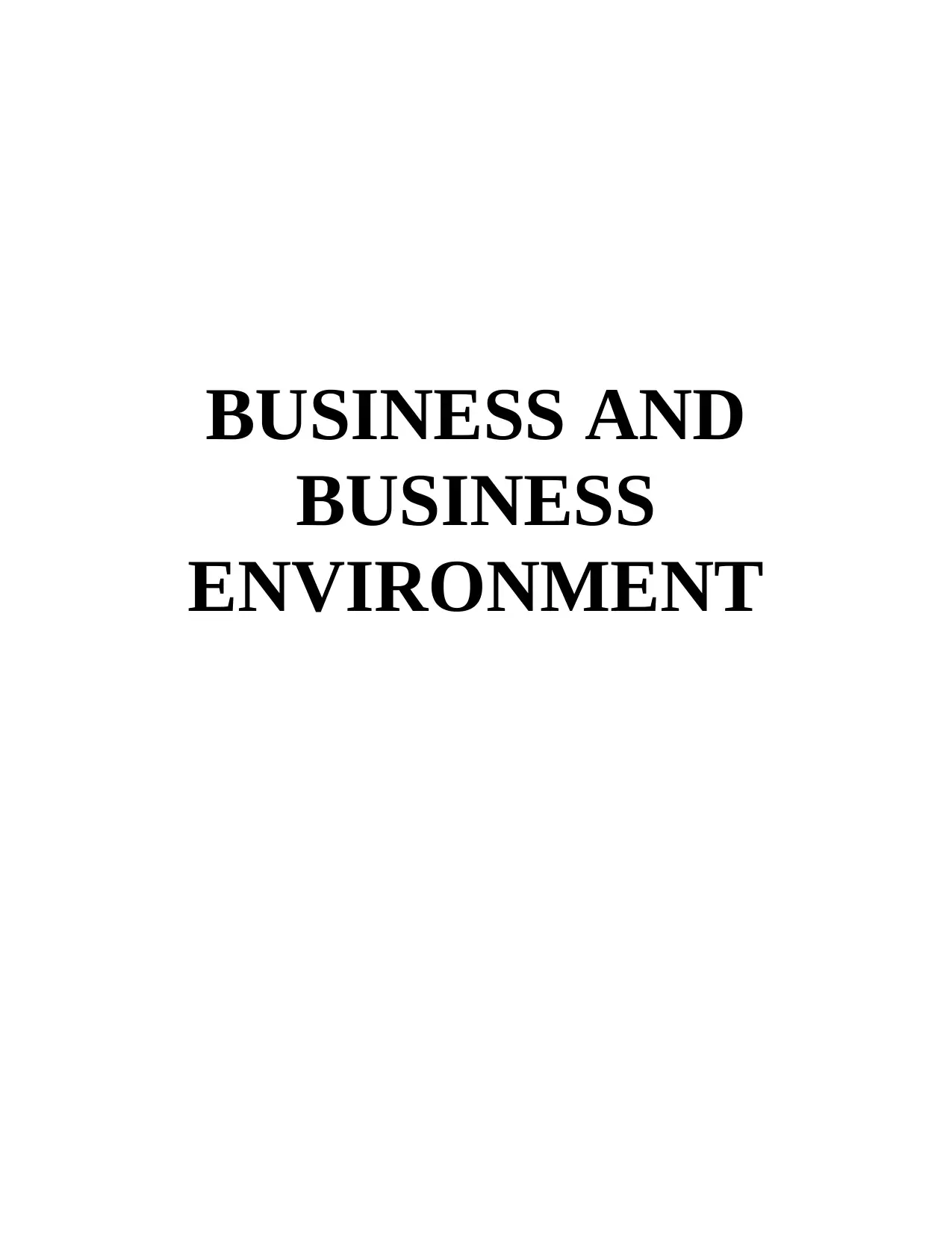
BUSINESS AND
BUSINESS
ENVIRONMENT
BUSINESS
ENVIRONMENT
Paraphrase This Document
Need a fresh take? Get an instant paraphrase of this document with our AI Paraphraser
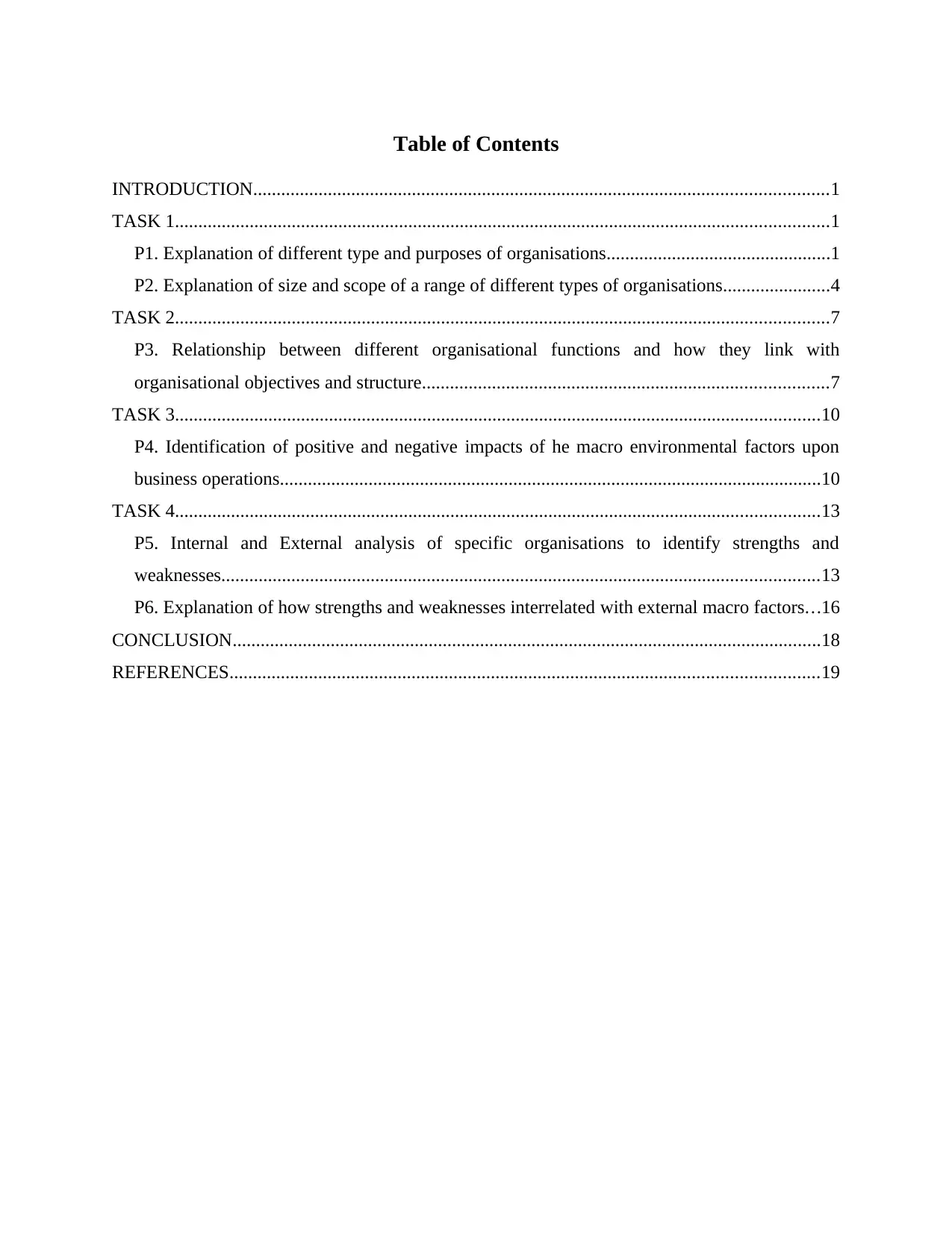
Table of Contents
INTRODUCTION...........................................................................................................................1
TASK 1............................................................................................................................................1
P1. Explanation of different type and purposes of organisations................................................1
P2. Explanation of size and scope of a range of different types of organisations.......................4
TASK 2............................................................................................................................................7
P3. Relationship between different organisational functions and how they link with
organisational objectives and structure.......................................................................................7
TASK 3..........................................................................................................................................10
P4. Identification of positive and negative impacts of he macro environmental factors upon
business operations....................................................................................................................10
TASK 4..........................................................................................................................................13
P5. Internal and External analysis of specific organisations to identify strengths and
weaknesses................................................................................................................................13
P6. Explanation of how strengths and weaknesses interrelated with external macro factors...16
CONCLUSION..............................................................................................................................18
REFERENCES..............................................................................................................................19
INTRODUCTION...........................................................................................................................1
TASK 1............................................................................................................................................1
P1. Explanation of different type and purposes of organisations................................................1
P2. Explanation of size and scope of a range of different types of organisations.......................4
TASK 2............................................................................................................................................7
P3. Relationship between different organisational functions and how they link with
organisational objectives and structure.......................................................................................7
TASK 3..........................................................................................................................................10
P4. Identification of positive and negative impacts of he macro environmental factors upon
business operations....................................................................................................................10
TASK 4..........................................................................................................................................13
P5. Internal and External analysis of specific organisations to identify strengths and
weaknesses................................................................................................................................13
P6. Explanation of how strengths and weaknesses interrelated with external macro factors...16
CONCLUSION..............................................................................................................................18
REFERENCES..............................................................................................................................19
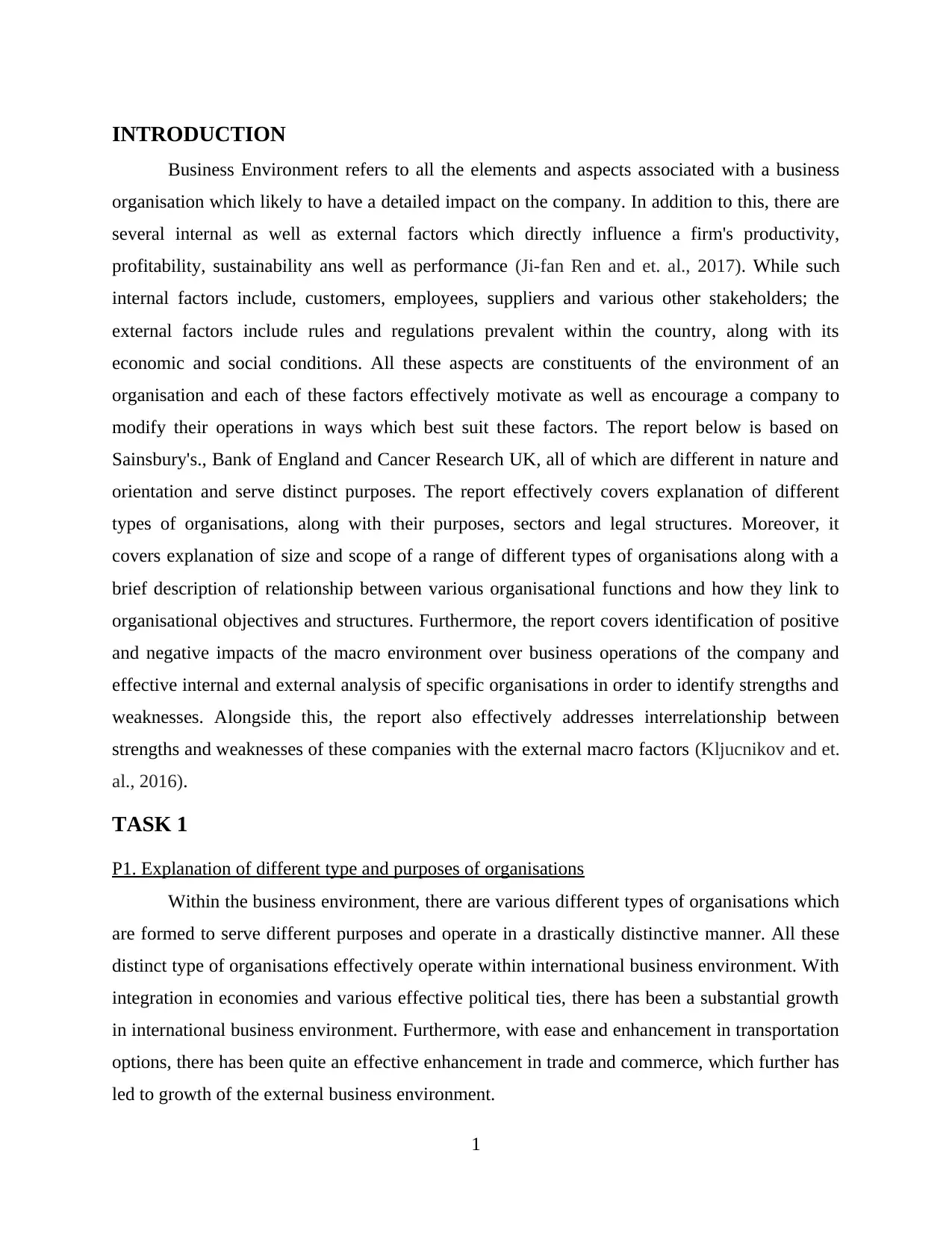
INTRODUCTION
Business Environment refers to all the elements and aspects associated with a business
organisation which likely to have a detailed impact on the company. In addition to this, there are
several internal as well as external factors which directly influence a firm's productivity,
profitability, sustainability ans well as performance (Ji-fan Ren and et. al., 2017). While such
internal factors include, customers, employees, suppliers and various other stakeholders; the
external factors include rules and regulations prevalent within the country, along with its
economic and social conditions. All these aspects are constituents of the environment of an
organisation and each of these factors effectively motivate as well as encourage a company to
modify their operations in ways which best suit these factors. The report below is based on
Sainsbury's., Bank of England and Cancer Research UK, all of which are different in nature and
orientation and serve distinct purposes. The report effectively covers explanation of different
types of organisations, along with their purposes, sectors and legal structures. Moreover, it
covers explanation of size and scope of a range of different types of organisations along with a
brief description of relationship between various organisational functions and how they link to
organisational objectives and structures. Furthermore, the report covers identification of positive
and negative impacts of the macro environment over business operations of the company and
effective internal and external analysis of specific organisations in order to identify strengths and
weaknesses. Alongside this, the report also effectively addresses interrelationship between
strengths and weaknesses of these companies with the external macro factors (Kljucnikov and et.
al., 2016).
TASK 1
P1. Explanation of different type and purposes of organisations
Within the business environment, there are various different types of organisations which
are formed to serve different purposes and operate in a drastically distinctive manner. All these
distinct type of organisations effectively operate within international business environment. With
integration in economies and various effective political ties, there has been a substantial growth
in international business environment. Furthermore, with ease and enhancement in transportation
options, there has been quite an effective enhancement in trade and commerce, which further has
led to growth of the external business environment.
1
Business Environment refers to all the elements and aspects associated with a business
organisation which likely to have a detailed impact on the company. In addition to this, there are
several internal as well as external factors which directly influence a firm's productivity,
profitability, sustainability ans well as performance (Ji-fan Ren and et. al., 2017). While such
internal factors include, customers, employees, suppliers and various other stakeholders; the
external factors include rules and regulations prevalent within the country, along with its
economic and social conditions. All these aspects are constituents of the environment of an
organisation and each of these factors effectively motivate as well as encourage a company to
modify their operations in ways which best suit these factors. The report below is based on
Sainsbury's., Bank of England and Cancer Research UK, all of which are different in nature and
orientation and serve distinct purposes. The report effectively covers explanation of different
types of organisations, along with their purposes, sectors and legal structures. Moreover, it
covers explanation of size and scope of a range of different types of organisations along with a
brief description of relationship between various organisational functions and how they link to
organisational objectives and structures. Furthermore, the report covers identification of positive
and negative impacts of the macro environment over business operations of the company and
effective internal and external analysis of specific organisations in order to identify strengths and
weaknesses. Alongside this, the report also effectively addresses interrelationship between
strengths and weaknesses of these companies with the external macro factors (Kljucnikov and et.
al., 2016).
TASK 1
P1. Explanation of different type and purposes of organisations
Within the business environment, there are various different types of organisations which
are formed to serve different purposes and operate in a drastically distinctive manner. All these
distinct type of organisations effectively operate within international business environment. With
integration in economies and various effective political ties, there has been a substantial growth
in international business environment. Furthermore, with ease and enhancement in transportation
options, there has been quite an effective enhancement in trade and commerce, which further has
led to growth of the external business environment.
1
⊘ This is a preview!⊘
Do you want full access?
Subscribe today to unlock all pages.

Trusted by 1+ million students worldwide
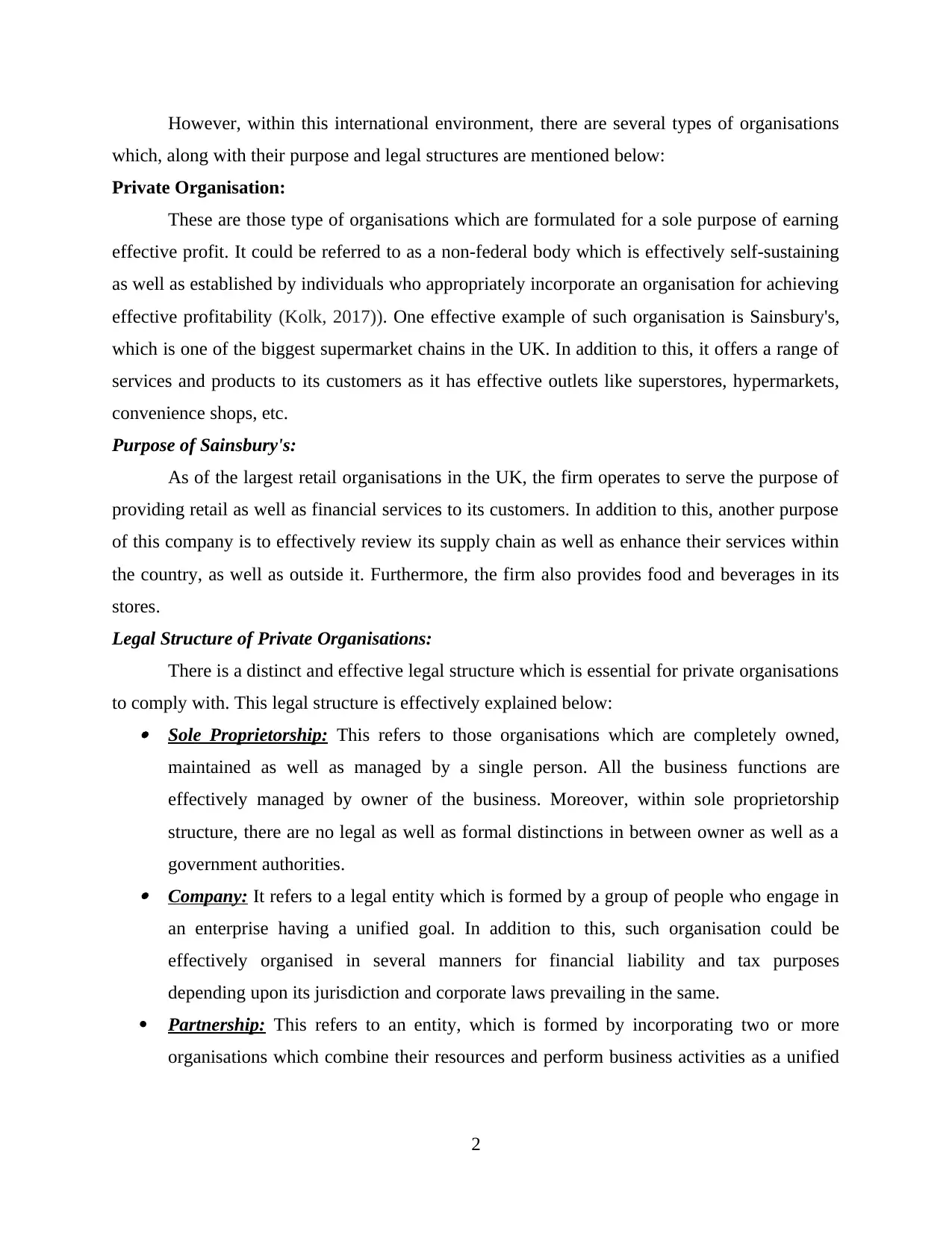
However, within this international environment, there are several types of organisations
which, along with their purpose and legal structures are mentioned below:
Private Organisation:
These are those type of organisations which are formulated for a sole purpose of earning
effective profit. It could be referred to as a non-federal body which is effectively self-sustaining
as well as established by individuals who appropriately incorporate an organisation for achieving
effective profitability (Kolk, 2017)). One effective example of such organisation is Sainsbury's,
which is one of the biggest supermarket chains in the UK. In addition to this, it offers a range of
services and products to its customers as it has effective outlets like superstores, hypermarkets,
convenience shops, etc.
Purpose of Sainsbury's:
As of the largest retail organisations in the UK, the firm operates to serve the purpose of
providing retail as well as financial services to its customers. In addition to this, another purpose
of this company is to effectively review its supply chain as well as enhance their services within
the country, as well as outside it. Furthermore, the firm also provides food and beverages in its
stores.
Legal Structure of Private Organisations:
There is a distinct and effective legal structure which is essential for private organisations
to comply with. This legal structure is effectively explained below: Sole Proprietorship: This refers to those organisations which are completely owned,
maintained as well as managed by a single person. All the business functions are
effectively managed by owner of the business. Moreover, within sole proprietorship
structure, there are no legal as well as formal distinctions in between owner as well as a
government authorities. Company: It refers to a legal entity which is formed by a group of people who engage in
an enterprise having a unified goal. In addition to this, such organisation could be
effectively organised in several manners for financial liability and tax purposes
depending upon its jurisdiction and corporate laws prevailing in the same.
Partnership: This refers to an entity, which is formed by incorporating two or more
organisations which combine their resources and perform business activities as a unified
2
which, along with their purpose and legal structures are mentioned below:
Private Organisation:
These are those type of organisations which are formulated for a sole purpose of earning
effective profit. It could be referred to as a non-federal body which is effectively self-sustaining
as well as established by individuals who appropriately incorporate an organisation for achieving
effective profitability (Kolk, 2017)). One effective example of such organisation is Sainsbury's,
which is one of the biggest supermarket chains in the UK. In addition to this, it offers a range of
services and products to its customers as it has effective outlets like superstores, hypermarkets,
convenience shops, etc.
Purpose of Sainsbury's:
As of the largest retail organisations in the UK, the firm operates to serve the purpose of
providing retail as well as financial services to its customers. In addition to this, another purpose
of this company is to effectively review its supply chain as well as enhance their services within
the country, as well as outside it. Furthermore, the firm also provides food and beverages in its
stores.
Legal Structure of Private Organisations:
There is a distinct and effective legal structure which is essential for private organisations
to comply with. This legal structure is effectively explained below: Sole Proprietorship: This refers to those organisations which are completely owned,
maintained as well as managed by a single person. All the business functions are
effectively managed by owner of the business. Moreover, within sole proprietorship
structure, there are no legal as well as formal distinctions in between owner as well as a
government authorities. Company: It refers to a legal entity which is formed by a group of people who engage in
an enterprise having a unified goal. In addition to this, such organisation could be
effectively organised in several manners for financial liability and tax purposes
depending upon its jurisdiction and corporate laws prevailing in the same.
Partnership: This refers to an entity, which is formed by incorporating two or more
organisations which combine their resources and perform business activities as a unified
2
Paraphrase This Document
Need a fresh take? Get an instant paraphrase of this document with our AI Paraphraser
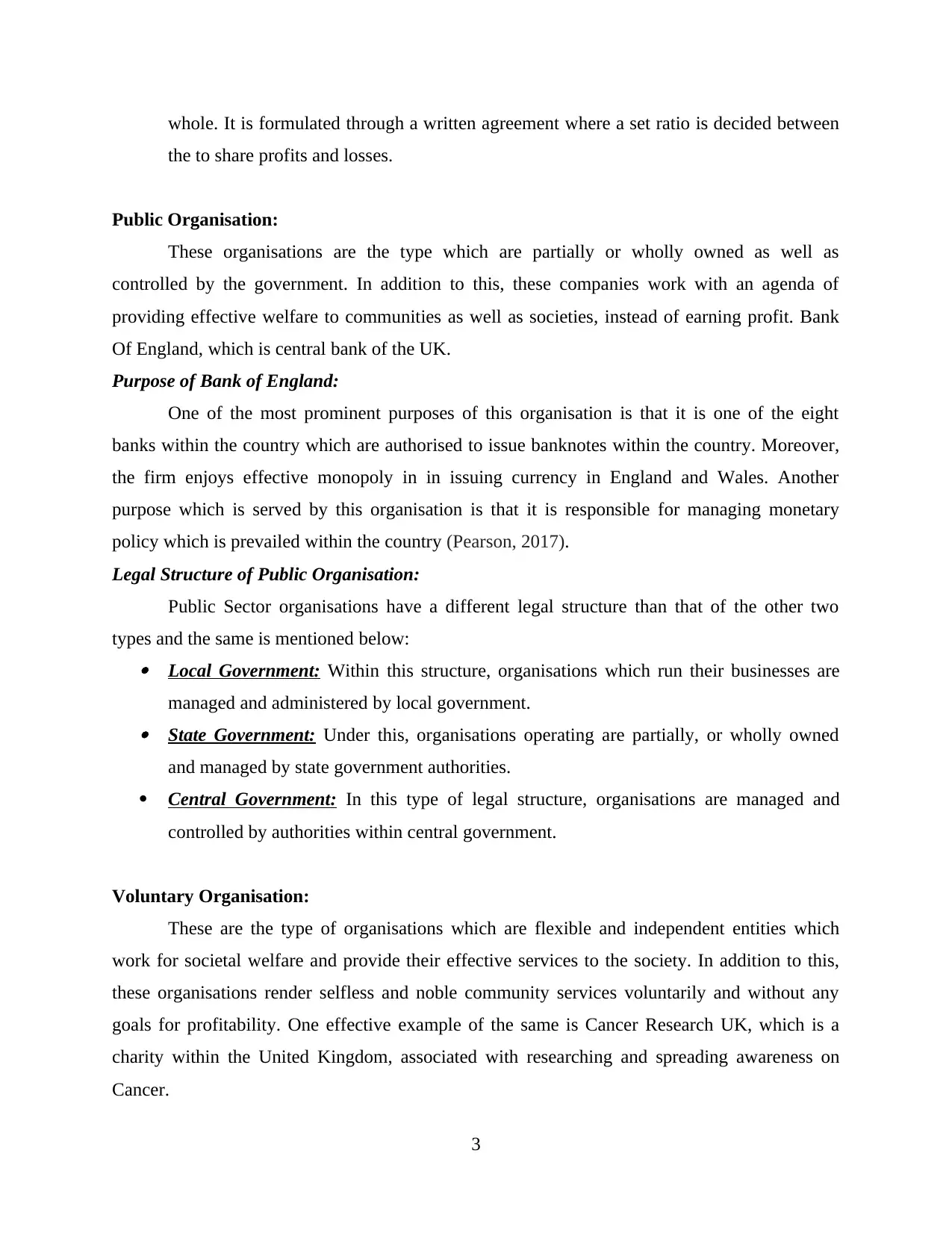
whole. It is formulated through a written agreement where a set ratio is decided between
the to share profits and losses.
Public Organisation:
These organisations are the type which are partially or wholly owned as well as
controlled by the government. In addition to this, these companies work with an agenda of
providing effective welfare to communities as well as societies, instead of earning profit. Bank
Of England, which is central bank of the UK.
Purpose of Bank of England:
One of the most prominent purposes of this organisation is that it is one of the eight
banks within the country which are authorised to issue banknotes within the country. Moreover,
the firm enjoys effective monopoly in in issuing currency in England and Wales. Another
purpose which is served by this organisation is that it is responsible for managing monetary
policy which is prevailed within the country (Pearson, 2017).
Legal Structure of Public Organisation:
Public Sector organisations have a different legal structure than that of the other two
types and the same is mentioned below: Local Government: Within this structure, organisations which run their businesses are
managed and administered by local government. State Government: Under this, organisations operating are partially, or wholly owned
and managed by state government authorities.
Central Government: In this type of legal structure, organisations are managed and
controlled by authorities within central government.
Voluntary Organisation:
These are the type of organisations which are flexible and independent entities which
work for societal welfare and provide their effective services to the society. In addition to this,
these organisations render selfless and noble community services voluntarily and without any
goals for profitability. One effective example of the same is Cancer Research UK, which is a
charity within the United Kingdom, associated with researching and spreading awareness on
Cancer.
3
the to share profits and losses.
Public Organisation:
These organisations are the type which are partially or wholly owned as well as
controlled by the government. In addition to this, these companies work with an agenda of
providing effective welfare to communities as well as societies, instead of earning profit. Bank
Of England, which is central bank of the UK.
Purpose of Bank of England:
One of the most prominent purposes of this organisation is that it is one of the eight
banks within the country which are authorised to issue banknotes within the country. Moreover,
the firm enjoys effective monopoly in in issuing currency in England and Wales. Another
purpose which is served by this organisation is that it is responsible for managing monetary
policy which is prevailed within the country (Pearson, 2017).
Legal Structure of Public Organisation:
Public Sector organisations have a different legal structure than that of the other two
types and the same is mentioned below: Local Government: Within this structure, organisations which run their businesses are
managed and administered by local government. State Government: Under this, organisations operating are partially, or wholly owned
and managed by state government authorities.
Central Government: In this type of legal structure, organisations are managed and
controlled by authorities within central government.
Voluntary Organisation:
These are the type of organisations which are flexible and independent entities which
work for societal welfare and provide their effective services to the society. In addition to this,
these organisations render selfless and noble community services voluntarily and without any
goals for profitability. One effective example of the same is Cancer Research UK, which is a
charity within the United Kingdom, associated with researching and spreading awareness on
Cancer.
3
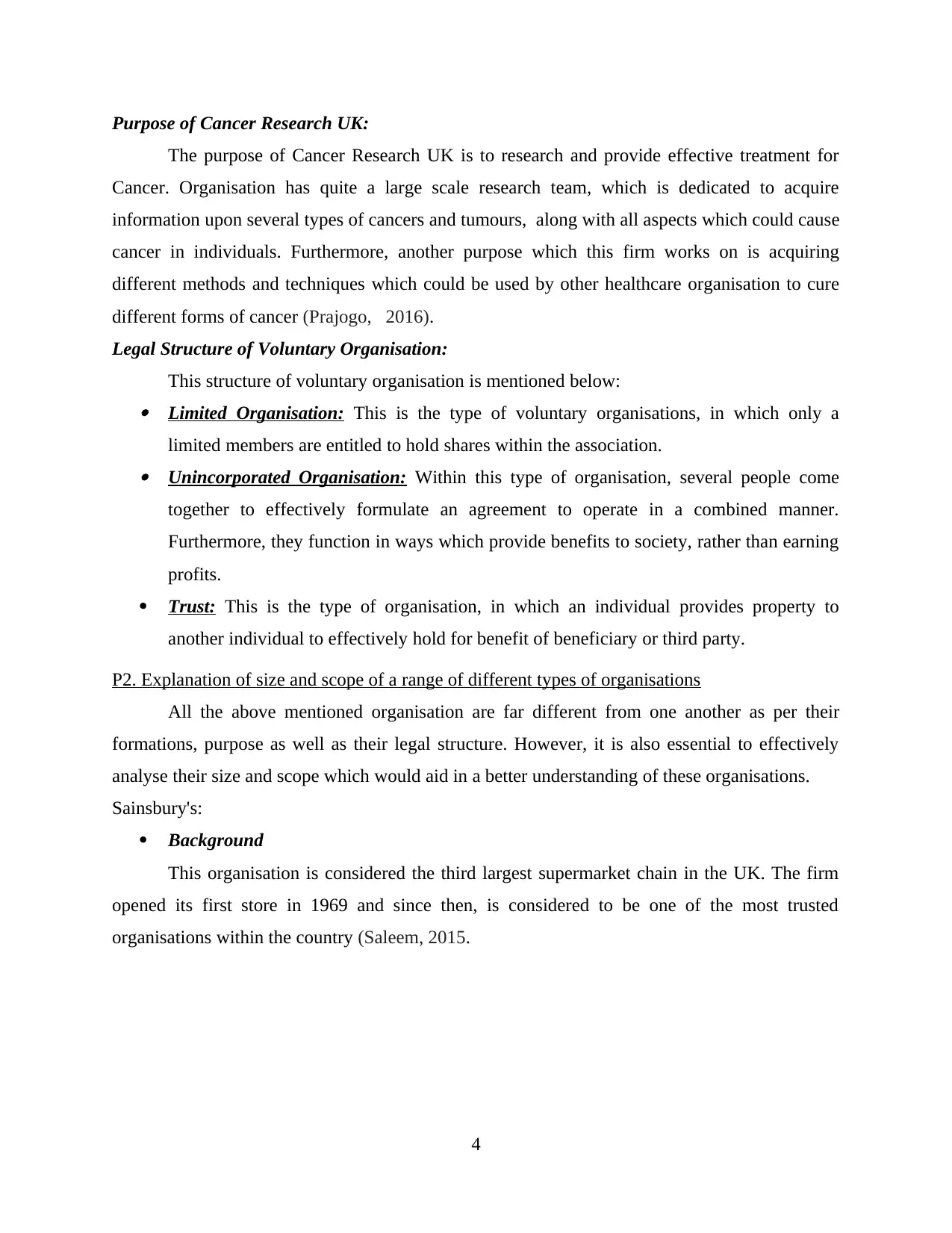
Purpose of Cancer Research UK:
The purpose of Cancer Research UK is to research and provide effective treatment for
Cancer. Organisation has quite a large scale research team, which is dedicated to acquire
information upon several types of cancers and tumours, along with all aspects which could cause
cancer in individuals. Furthermore, another purpose which this firm works on is acquiring
different methods and techniques which could be used by other healthcare organisation to cure
different forms of cancer (Prajogo, 2016).
Legal Structure of Voluntary Organisation:
This structure of voluntary organisation is mentioned below: Limited Organisation: This is the type of voluntary organisations, in which only a
limited members are entitled to hold shares within the association. Unincorporated Organisation: Within this type of organisation, several people come
together to effectively formulate an agreement to operate in a combined manner.
Furthermore, they function in ways which provide benefits to society, rather than earning
profits.
Trust: This is the type of organisation, in which an individual provides property to
another individual to effectively hold for benefit of beneficiary or third party.
P2. Explanation of size and scope of a range of different types of organisations
All the above mentioned organisation are far different from one another as per their
formations, purpose as well as their legal structure. However, it is also essential to effectively
analyse their size and scope which would aid in a better understanding of these organisations.
Sainsbury's:
Background
This organisation is considered the third largest supermarket chain in the UK. The firm
opened its first store in 1969 and since then, is considered to be one of the most trusted
organisations within the country (Saleem, 2015.
4
The purpose of Cancer Research UK is to research and provide effective treatment for
Cancer. Organisation has quite a large scale research team, which is dedicated to acquire
information upon several types of cancers and tumours, along with all aspects which could cause
cancer in individuals. Furthermore, another purpose which this firm works on is acquiring
different methods and techniques which could be used by other healthcare organisation to cure
different forms of cancer (Prajogo, 2016).
Legal Structure of Voluntary Organisation:
This structure of voluntary organisation is mentioned below: Limited Organisation: This is the type of voluntary organisations, in which only a
limited members are entitled to hold shares within the association. Unincorporated Organisation: Within this type of organisation, several people come
together to effectively formulate an agreement to operate in a combined manner.
Furthermore, they function in ways which provide benefits to society, rather than earning
profits.
Trust: This is the type of organisation, in which an individual provides property to
another individual to effectively hold for benefit of beneficiary or third party.
P2. Explanation of size and scope of a range of different types of organisations
All the above mentioned organisation are far different from one another as per their
formations, purpose as well as their legal structure. However, it is also essential to effectively
analyse their size and scope which would aid in a better understanding of these organisations.
Sainsbury's:
Background
This organisation is considered the third largest supermarket chain in the UK. The firm
opened its first store in 1969 and since then, is considered to be one of the most trusted
organisations within the country (Saleem, 2015.
4
⊘ This is a preview!⊘
Do you want full access?
Subscribe today to unlock all pages.

Trusted by 1+ million students worldwide
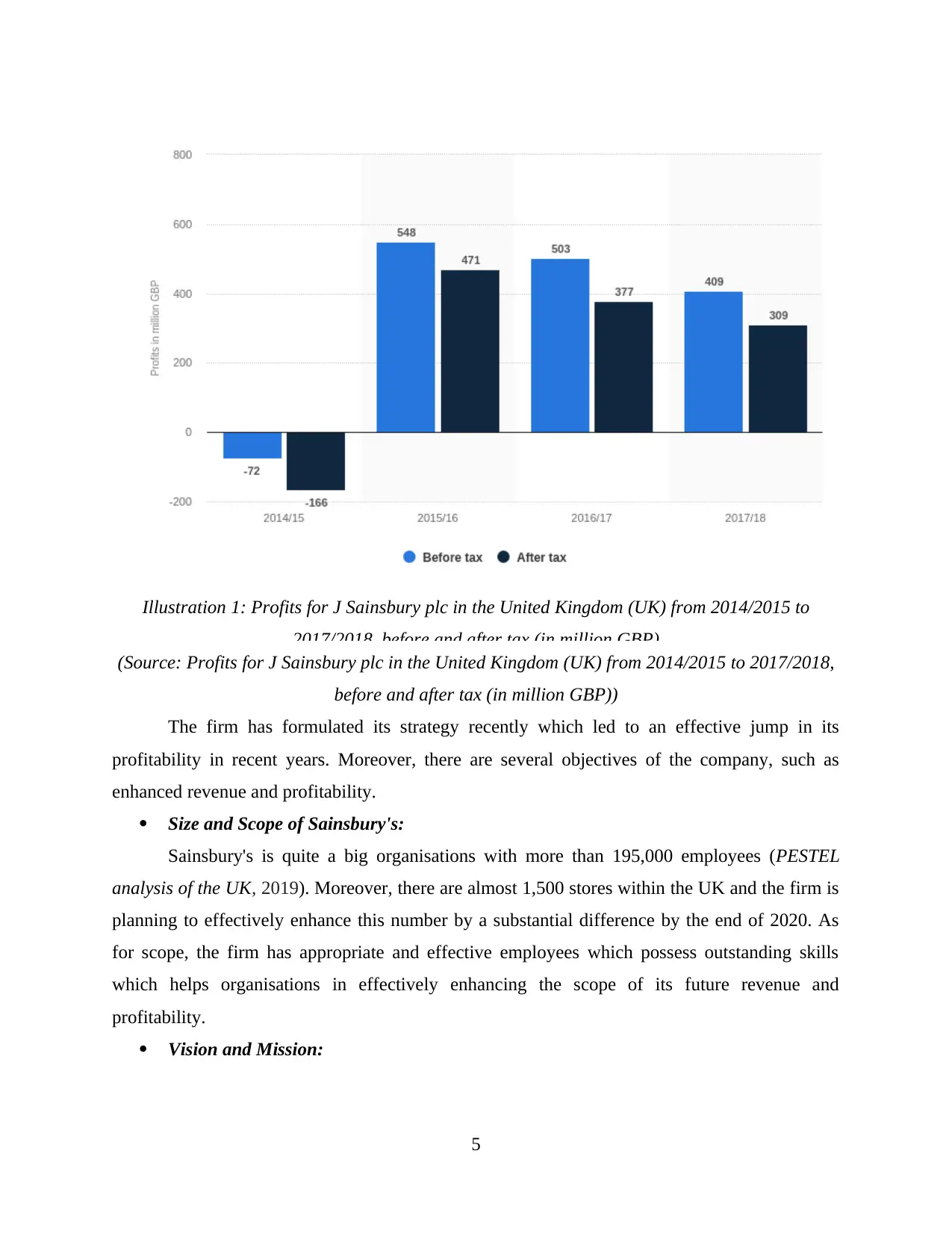
Illustration 1: Profits for J Sainsbury plc in the United Kingdom (UK) from 2014/2015 to
2017/2018, before and after tax (in million GBP)
(Source: Profits for J Sainsbury plc in the United Kingdom (UK) from 2014/2015 to 2017/2018,
before and after tax (in million GBP))
The firm has formulated its strategy recently which led to an effective jump in its
profitability in recent years. Moreover, there are several objectives of the company, such as
enhanced revenue and profitability.
Size and Scope of Sainsbury's:
Sainsbury's is quite a big organisations with more than 195,000 employees (PESTEL
analysis of the UK, 2019). Moreover, there are almost 1,500 stores within the UK and the firm is
planning to effectively enhance this number by a substantial difference by the end of 2020. As
for scope, the firm has appropriate and effective employees which possess outstanding skills
which helps organisations in effectively enhancing the scope of its future revenue and
profitability.
Vision and Mission:
5
2017/2018, before and after tax (in million GBP)
(Source: Profits for J Sainsbury plc in the United Kingdom (UK) from 2014/2015 to 2017/2018,
before and after tax (in million GBP))
The firm has formulated its strategy recently which led to an effective jump in its
profitability in recent years. Moreover, there are several objectives of the company, such as
enhanced revenue and profitability.
Size and Scope of Sainsbury's:
Sainsbury's is quite a big organisations with more than 195,000 employees (PESTEL
analysis of the UK, 2019). Moreover, there are almost 1,500 stores within the UK and the firm is
planning to effectively enhance this number by a substantial difference by the end of 2020. As
for scope, the firm has appropriate and effective employees which possess outstanding skills
which helps organisations in effectively enhancing the scope of its future revenue and
profitability.
Vision and Mission:
5
Paraphrase This Document
Need a fresh take? Get an instant paraphrase of this document with our AI Paraphraser
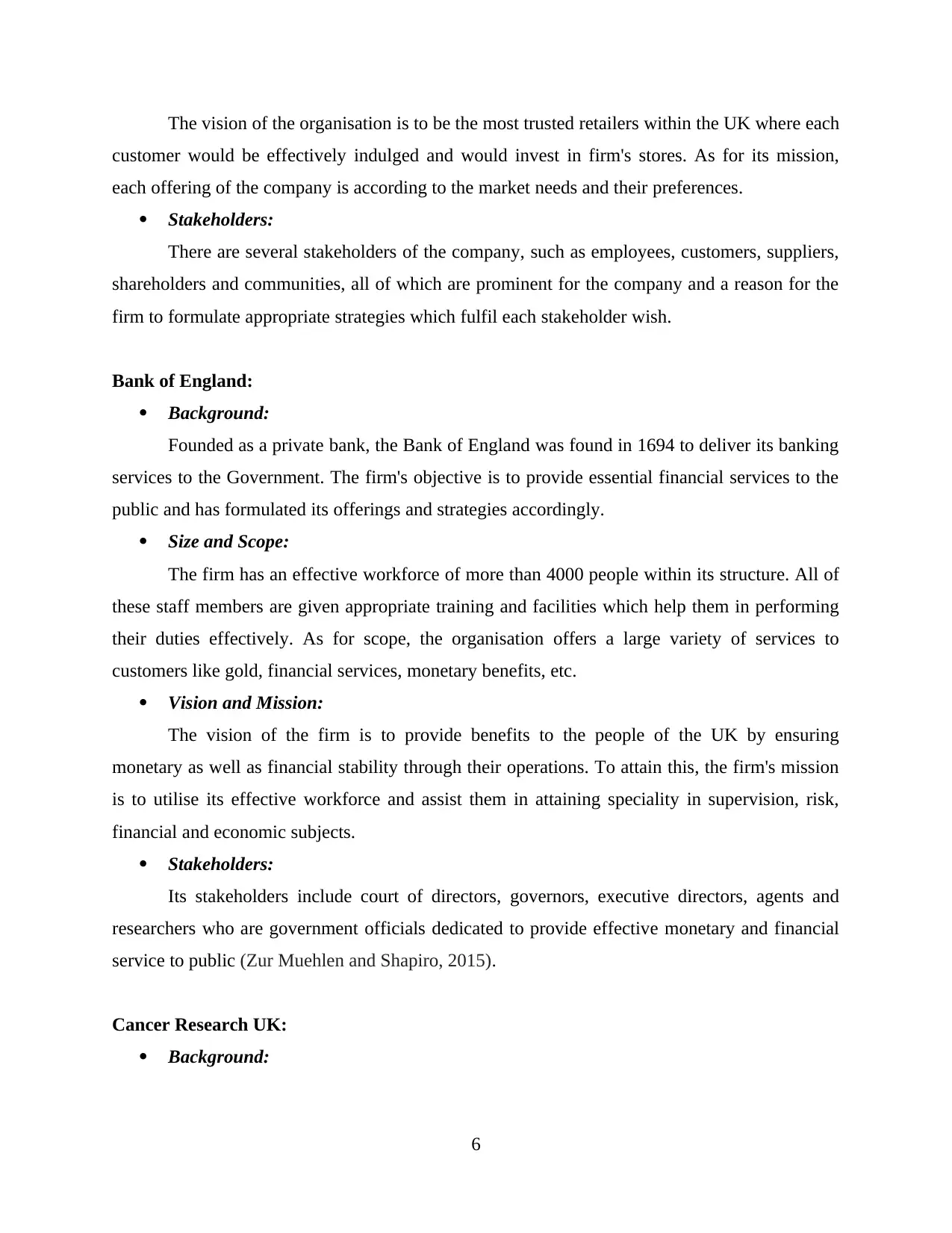
The vision of the organisation is to be the most trusted retailers within the UK where each
customer would be effectively indulged and would invest in firm's stores. As for its mission,
each offering of the company is according to the market needs and their preferences.
Stakeholders:
There are several stakeholders of the company, such as employees, customers, suppliers,
shareholders and communities, all of which are prominent for the company and a reason for the
firm to formulate appropriate strategies which fulfil each stakeholder wish.
Bank of England:
Background:
Founded as a private bank, the Bank of England was found in 1694 to deliver its banking
services to the Government. The firm's objective is to provide essential financial services to the
public and has formulated its offerings and strategies accordingly.
Size and Scope:
The firm has an effective workforce of more than 4000 people within its structure. All of
these staff members are given appropriate training and facilities which help them in performing
their duties effectively. As for scope, the organisation offers a large variety of services to
customers like gold, financial services, monetary benefits, etc.
Vision and Mission:
The vision of the firm is to provide benefits to the people of the UK by ensuring
monetary as well as financial stability through their operations. To attain this, the firm's mission
is to utilise its effective workforce and assist them in attaining speciality in supervision, risk,
financial and economic subjects.
Stakeholders:
Its stakeholders include court of directors, governors, executive directors, agents and
researchers who are government officials dedicated to provide effective monetary and financial
service to public (Zur Muehlen and Shapiro, 2015).
Cancer Research UK:
Background:
6
customer would be effectively indulged and would invest in firm's stores. As for its mission,
each offering of the company is according to the market needs and their preferences.
Stakeholders:
There are several stakeholders of the company, such as employees, customers, suppliers,
shareholders and communities, all of which are prominent for the company and a reason for the
firm to formulate appropriate strategies which fulfil each stakeholder wish.
Bank of England:
Background:
Founded as a private bank, the Bank of England was found in 1694 to deliver its banking
services to the Government. The firm's objective is to provide essential financial services to the
public and has formulated its offerings and strategies accordingly.
Size and Scope:
The firm has an effective workforce of more than 4000 people within its structure. All of
these staff members are given appropriate training and facilities which help them in performing
their duties effectively. As for scope, the organisation offers a large variety of services to
customers like gold, financial services, monetary benefits, etc.
Vision and Mission:
The vision of the firm is to provide benefits to the people of the UK by ensuring
monetary as well as financial stability through their operations. To attain this, the firm's mission
is to utilise its effective workforce and assist them in attaining speciality in supervision, risk,
financial and economic subjects.
Stakeholders:
Its stakeholders include court of directors, governors, executive directors, agents and
researchers who are government officials dedicated to provide effective monetary and financial
service to public (Zur Muehlen and Shapiro, 2015).
Cancer Research UK:
Background:
6
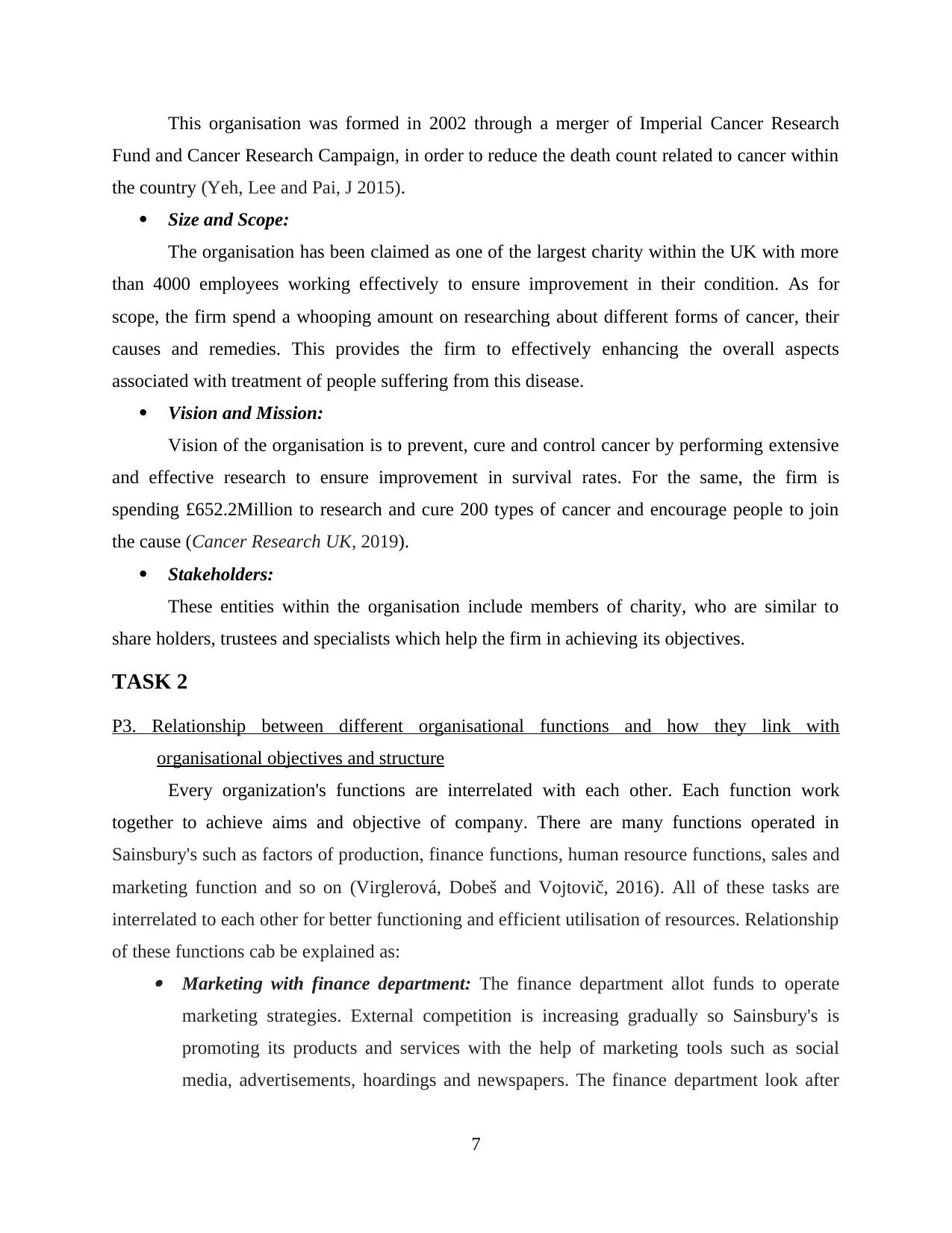
This organisation was formed in 2002 through a merger of Imperial Cancer Research
Fund and Cancer Research Campaign, in order to reduce the death count related to cancer within
the country (Yeh, Lee and Pai, J 2015).
Size and Scope:
The organisation has been claimed as one of the largest charity within the UK with more
than 4000 employees working effectively to ensure improvement in their condition. As for
scope, the firm spend a whooping amount on researching about different forms of cancer, their
causes and remedies. This provides the firm to effectively enhancing the overall aspects
associated with treatment of people suffering from this disease.
Vision and Mission:
Vision of the organisation is to prevent, cure and control cancer by performing extensive
and effective research to ensure improvement in survival rates. For the same, the firm is
spending £652.2Million to research and cure 200 types of cancer and encourage people to join
the cause (Cancer Research UK, 2019).
Stakeholders:
These entities within the organisation include members of charity, who are similar to
share holders, trustees and specialists which help the firm in achieving its objectives.
TASK 2
P3. Relationship between different organisational functions and how they link with
organisational objectives and structure
Every organization's functions are interrelated with each other. Each function work
together to achieve aims and objective of company. There are many functions operated in
Sainsbury's such as factors of production, finance functions, human resource functions, sales and
marketing function and so on (Virglerová, Dobeš and Vojtovič, 2016). All of these tasks are
interrelated to each other for better functioning and efficient utilisation of resources. Relationship
of these functions cab be explained as: Marketing with finance department: The finance department allot funds to operate
marketing strategies. External competition is increasing gradually so Sainsbury's is
promoting its products and services with the help of marketing tools such as social
media, advertisements, hoardings and newspapers. The finance department look after
7
Fund and Cancer Research Campaign, in order to reduce the death count related to cancer within
the country (Yeh, Lee and Pai, J 2015).
Size and Scope:
The organisation has been claimed as one of the largest charity within the UK with more
than 4000 employees working effectively to ensure improvement in their condition. As for
scope, the firm spend a whooping amount on researching about different forms of cancer, their
causes and remedies. This provides the firm to effectively enhancing the overall aspects
associated with treatment of people suffering from this disease.
Vision and Mission:
Vision of the organisation is to prevent, cure and control cancer by performing extensive
and effective research to ensure improvement in survival rates. For the same, the firm is
spending £652.2Million to research and cure 200 types of cancer and encourage people to join
the cause (Cancer Research UK, 2019).
Stakeholders:
These entities within the organisation include members of charity, who are similar to
share holders, trustees and specialists which help the firm in achieving its objectives.
TASK 2
P3. Relationship between different organisational functions and how they link with
organisational objectives and structure
Every organization's functions are interrelated with each other. Each function work
together to achieve aims and objective of company. There are many functions operated in
Sainsbury's such as factors of production, finance functions, human resource functions, sales and
marketing function and so on (Virglerová, Dobeš and Vojtovič, 2016). All of these tasks are
interrelated to each other for better functioning and efficient utilisation of resources. Relationship
of these functions cab be explained as: Marketing with finance department: The finance department allot funds to operate
marketing strategies. External competition is increasing gradually so Sainsbury's is
promoting its products and services with the help of marketing tools such as social
media, advertisements, hoardings and newspapers. The finance department look after
7
⊘ This is a preview!⊘
Do you want full access?
Subscribe today to unlock all pages.

Trusted by 1+ million students worldwide
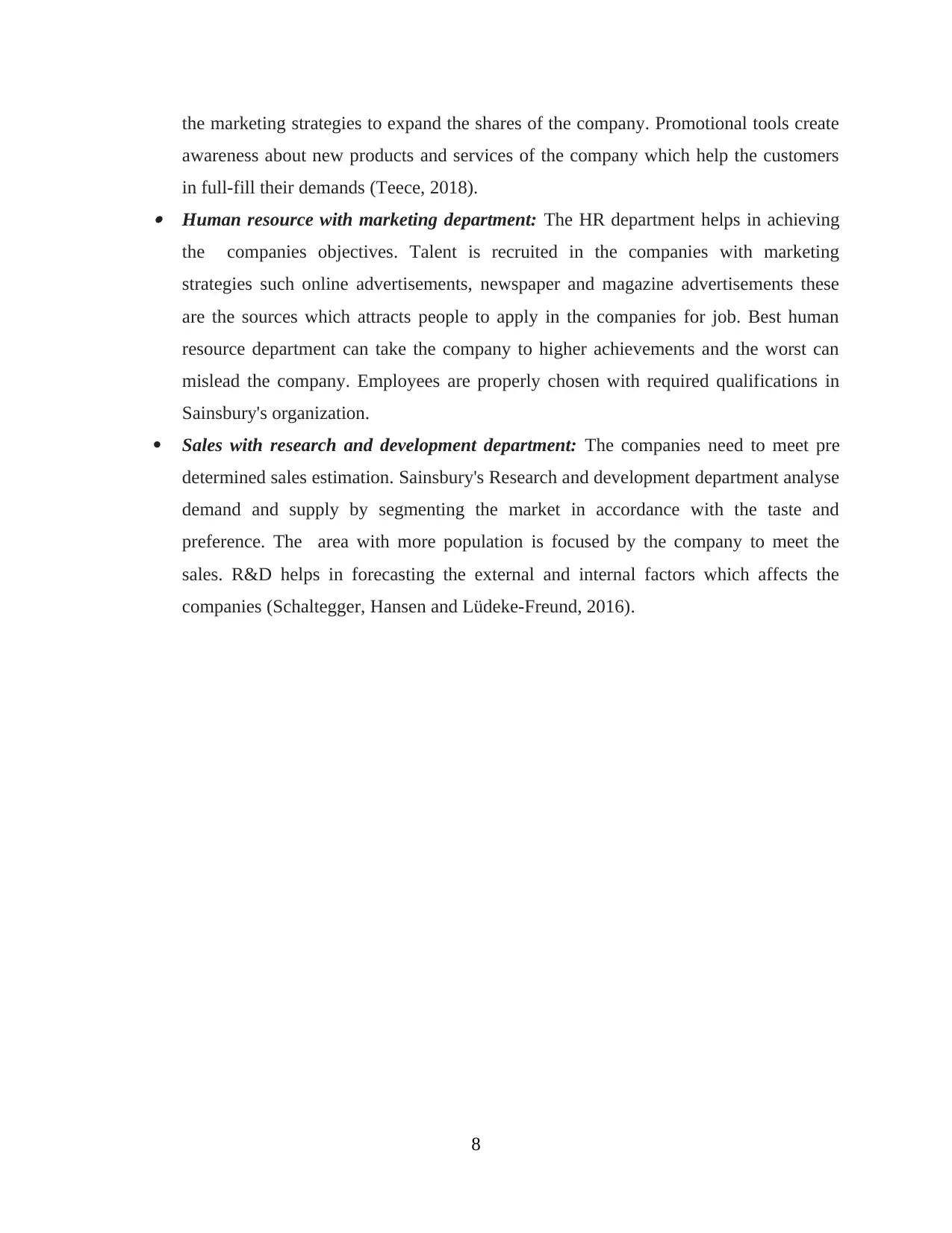
the marketing strategies to expand the shares of the company. Promotional tools create
awareness about new products and services of the company which help the customers
in full-fill their demands (Teece, 2018). Human resource with marketing department: The HR department helps in achieving
the companies objectives. Talent is recruited in the companies with marketing
strategies such online advertisements, newspaper and magazine advertisements these
are the sources which attracts people to apply in the companies for job. Best human
resource department can take the company to higher achievements and the worst can
mislead the company. Employees are properly chosen with required qualifications in
Sainsbury's organization.
Sales with research and development department: The companies need to meet pre
determined sales estimation. Sainsbury's Research and development department analyse
demand and supply by segmenting the market in accordance with the taste and
preference. The area with more population is focused by the company to meet the
sales. R&D helps in forecasting the external and internal factors which affects the
companies (Schaltegger, Hansen and Lüdeke-Freund, 2016).
8
awareness about new products and services of the company which help the customers
in full-fill their demands (Teece, 2018). Human resource with marketing department: The HR department helps in achieving
the companies objectives. Talent is recruited in the companies with marketing
strategies such online advertisements, newspaper and magazine advertisements these
are the sources which attracts people to apply in the companies for job. Best human
resource department can take the company to higher achievements and the worst can
mislead the company. Employees are properly chosen with required qualifications in
Sainsbury's organization.
Sales with research and development department: The companies need to meet pre
determined sales estimation. Sainsbury's Research and development department analyse
demand and supply by segmenting the market in accordance with the taste and
preference. The area with more population is focused by the company to meet the
sales. R&D helps in forecasting the external and internal factors which affects the
companies (Schaltegger, Hansen and Lüdeke-Freund, 2016).
8
Paraphrase This Document
Need a fresh take? Get an instant paraphrase of this document with our AI Paraphraser
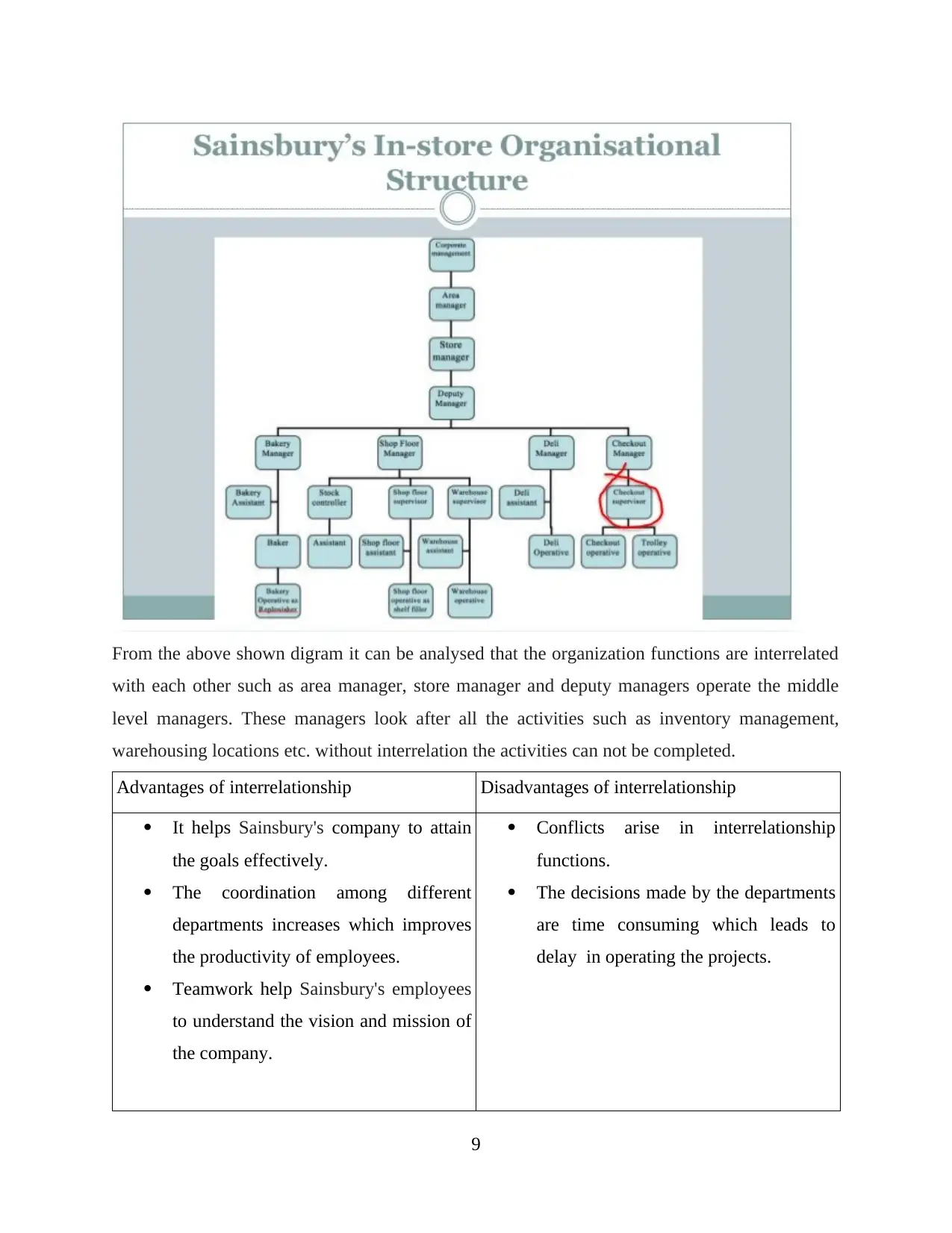
From the above shown digram it can be analysed that the organization functions are interrelated
with each other such as area manager, store manager and deputy managers operate the middle
level managers. These managers look after all the activities such as inventory management,
warehousing locations etc. without interrelation the activities can not be completed.
Advantages of interrelationship Disadvantages of interrelationship
It helps Sainsbury's company to attain
the goals effectively.
The coordination among different
departments increases which improves
the productivity of employees.
Teamwork help Sainsbury's employees
to understand the vision and mission of
the company.
Conflicts arise in interrelationship
functions.
The decisions made by the departments
are time consuming which leads to
delay in operating the projects.
9
with each other such as area manager, store manager and deputy managers operate the middle
level managers. These managers look after all the activities such as inventory management,
warehousing locations etc. without interrelation the activities can not be completed.
Advantages of interrelationship Disadvantages of interrelationship
It helps Sainsbury's company to attain
the goals effectively.
The coordination among different
departments increases which improves
the productivity of employees.
Teamwork help Sainsbury's employees
to understand the vision and mission of
the company.
Conflicts arise in interrelationship
functions.
The decisions made by the departments
are time consuming which leads to
delay in operating the projects.
9
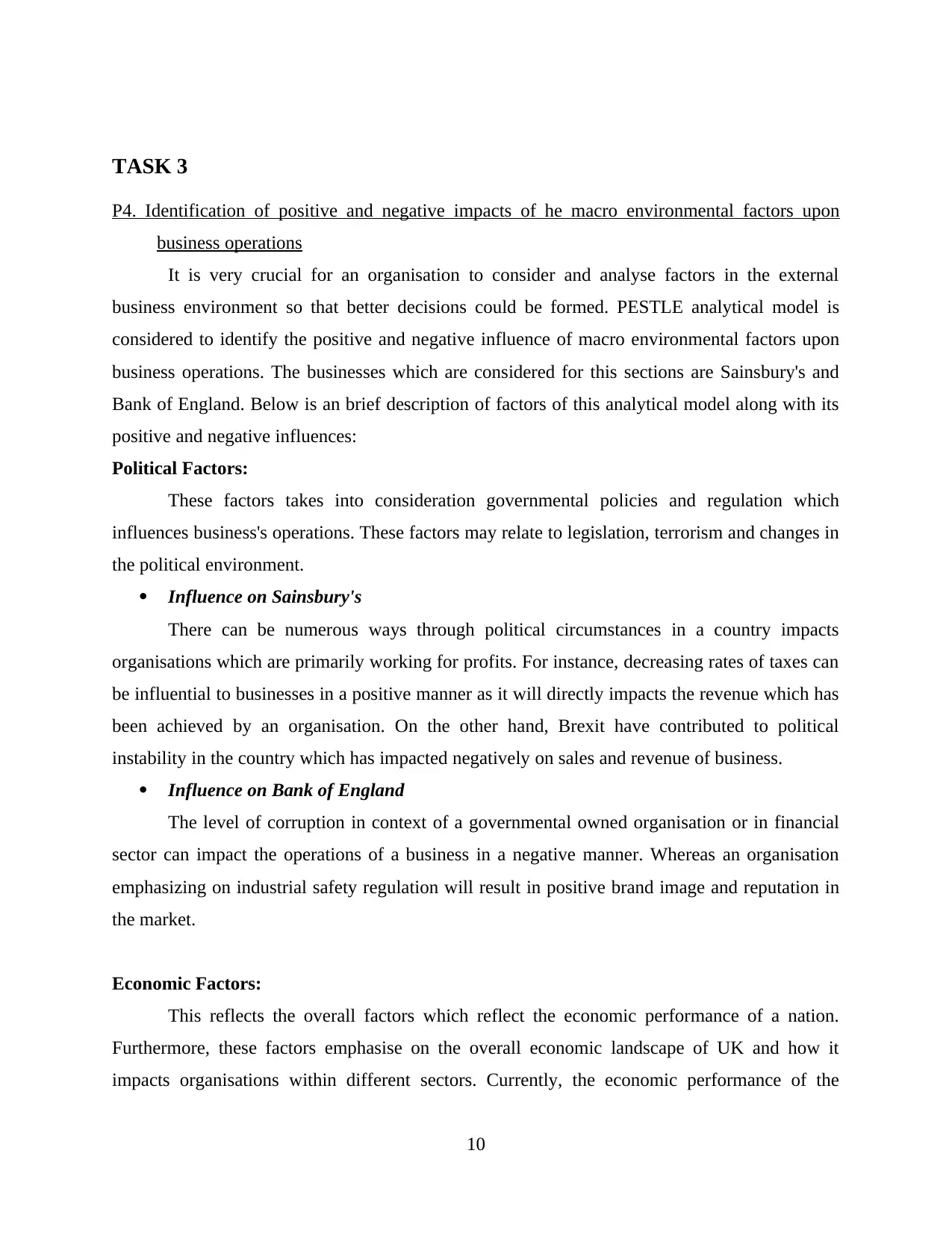
TASK 3
P4. Identification of positive and negative impacts of he macro environmental factors upon
business operations
It is very crucial for an organisation to consider and analyse factors in the external
business environment so that better decisions could be formed. PESTLE analytical model is
considered to identify the positive and negative influence of macro environmental factors upon
business operations. The businesses which are considered for this sections are Sainsbury's and
Bank of England. Below is an brief description of factors of this analytical model along with its
positive and negative influences:
Political Factors:
These factors takes into consideration governmental policies and regulation which
influences business's operations. These factors may relate to legislation, terrorism and changes in
the political environment.
Influence on Sainsbury's
There can be numerous ways through political circumstances in a country impacts
organisations which are primarily working for profits. For instance, decreasing rates of taxes can
be influential to businesses in a positive manner as it will directly impacts the revenue which has
been achieved by an organisation. On the other hand, Brexit have contributed to political
instability in the country which has impacted negatively on sales and revenue of business.
Influence on Bank of England
The level of corruption in context of a governmental owned organisation or in financial
sector can impact the operations of a business in a negative manner. Whereas an organisation
emphasizing on industrial safety regulation will result in positive brand image and reputation in
the market.
Economic Factors:
This reflects the overall factors which reflect the economic performance of a nation.
Furthermore, these factors emphasise on the overall economic landscape of UK and how it
impacts organisations within different sectors. Currently, the economic performance of the
10
P4. Identification of positive and negative impacts of he macro environmental factors upon
business operations
It is very crucial for an organisation to consider and analyse factors in the external
business environment so that better decisions could be formed. PESTLE analytical model is
considered to identify the positive and negative influence of macro environmental factors upon
business operations. The businesses which are considered for this sections are Sainsbury's and
Bank of England. Below is an brief description of factors of this analytical model along with its
positive and negative influences:
Political Factors:
These factors takes into consideration governmental policies and regulation which
influences business's operations. These factors may relate to legislation, terrorism and changes in
the political environment.
Influence on Sainsbury's
There can be numerous ways through political circumstances in a country impacts
organisations which are primarily working for profits. For instance, decreasing rates of taxes can
be influential to businesses in a positive manner as it will directly impacts the revenue which has
been achieved by an organisation. On the other hand, Brexit have contributed to political
instability in the country which has impacted negatively on sales and revenue of business.
Influence on Bank of England
The level of corruption in context of a governmental owned organisation or in financial
sector can impact the operations of a business in a negative manner. Whereas an organisation
emphasizing on industrial safety regulation will result in positive brand image and reputation in
the market.
Economic Factors:
This reflects the overall factors which reflect the economic performance of a nation.
Furthermore, these factors emphasise on the overall economic landscape of UK and how it
impacts organisations within different sectors. Currently, the economic performance of the
10
⊘ This is a preview!⊘
Do you want full access?
Subscribe today to unlock all pages.

Trusted by 1+ million students worldwide
1 out of 22
Related Documents
Your All-in-One AI-Powered Toolkit for Academic Success.
+13062052269
info@desklib.com
Available 24*7 on WhatsApp / Email
![[object Object]](/_next/static/media/star-bottom.7253800d.svg)
Unlock your academic potential
Copyright © 2020–2025 A2Z Services. All Rights Reserved. Developed and managed by ZUCOL.





